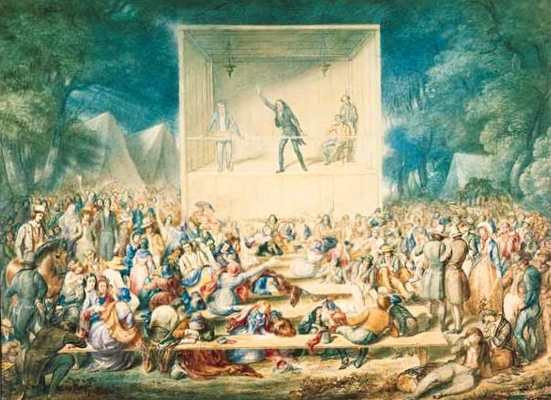Restoration movement (Christianity)
Enlarge text Shrink textThe Restoration Movement (also known as the American Restoration Movement or the Stone–Campbell Movement, and pejoratively as Campbellism) is a Christian movement that began on the United States frontier during the Second Great Awakening (1790–1840) of the early 19th century. The pioneers of this movement were seeking to reform the church from within and sought "the unification of all Christians in a single body patterned after the church of the New Testament.": 54 The Restoration Movement developed from several independent strands of religious revival that idealized early Christianity. Two groups which independently developed similar approaches to the Christian faith were particularly important. The first, led by Barton W. Stone, began at Cane Ridge, Kentucky, and identified as "Christians". The second began in western Pennsylvania and Virginia (now West Virginia) and was led by Thomas Campbell and his son, Alexander Campbell, both educated in Scotland; they eventually used the name "Disciples of Christ". Both groups sought to restore the Christian church based on visible patterns outlined in the New Testament, and both believed that creeds kept Christianity divided. In 1832, they joined in fellowship with a handshake. Among other things, they were united in the belief that Jesus is the Christ, the Son of God; that Christians should celebrate the Lord's Supper on the first day of each week; and that baptism of adult believers was necessarily by immersion in water.: 147–148 Because the founders wanted to abandon all denominational labels, they used the biblical names for the followers of Jesus.: 27 Both groups promoted a return to the purposes of the 1st-century churches as described in the New Testament. One historian of the movement has argued that it was primarily a unity movement, with the restoration motif playing a subordinate role.: 8 The Restoration Movement has since been divided into multiple separate groups. The three main groups are the Churches of Christ, the Christian Church (Disciples of Christ), and the independent Christian Church/Church of Christ congregations. Additionally, there are the International Churches of Christ, the International Christian Church, the Churches of Christ in Europe, and the Evangelical Christian Church in Canada, and the Churches of Christ in Australia. Some characterize the divisions in the movement as the result of the tension between the goals of restoration and ecumenism: the Churches of Christ and unaffiliated Christian Church/Church of Christ congregations resolved the tension by stressing restoration, while the Christian Church (Disciples of Christ) resolved the tension by stressing ecumenism.: 383
Read more on Wikipedia >
 Topic
Topic











